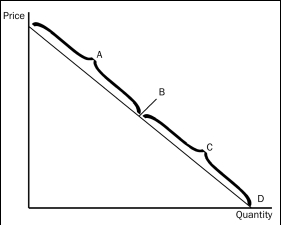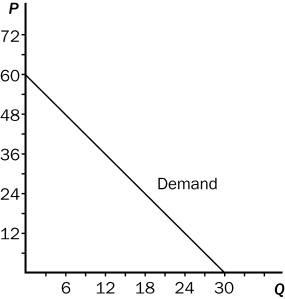A) less than 1.
B) equal to 1.
C) equal to 0.
D) greater than 1.
F) B) and C)
Correct Answer

verified
Correct Answer
verified
True/False
Cross-price elasticity of demand measures how the quantity demanded of one good changes as the price of another good changes.
B) False
Correct Answer

verified
Correct Answer
verified
Multiple Choice
Which of the following expressions represents a cross-price elasticity of demand?
A) percentage change in quantity demanded of apples divided by percentage change in quantity supplied of apples
B) percentage change in quantity demanded of apples divided by percentage change in price of pears
C) percentage change in price of apples divided by percentage change in quantity demanded of apples
D) percentage change in quantity demanded of apples divided by percentage change in income
F) C) and D)
Correct Answer

verified
Correct Answer
verified
Multiple Choice
Figure 5-1
 -Refer to Figure 5-1.The section of the demand curve labeled A represents the
-Refer to Figure 5-1.The section of the demand curve labeled A represents the
A) elastic section of the demand curve.
B) inelastic section of the demand curve.
C) unit elastic section of the demand curve.
D) perfectly elastic section of the demand curve.
F) A) and B)
Correct Answer

verified
Correct Answer
verified
Multiple Choice
When the local used bookstore prices economics books at $15.00 each,they generally sell 70 books per month.If they lower the price to $7.00,sales increase to 90 books per month.Given this information,we know that the price elasticity of demand for economics books is about
A) 2.91, and an increase in price from $7.00 to $15.00 results in an increase in total revenue.
B) 2.91, and an increase in price from $7.00 to $15.00 results in a decrease in total revenue.
C) 0.34, and an increase in price from $7.00 to $15.00 results in an increase in total revenue.
D) 0.34, and an increase in price from $7.00 to $15.00 results in a decrease in total revenue.
F) A) and D)
Correct Answer

verified
Correct Answer
verified
Multiple Choice
The midpoint method for calculating elasticities is convenient in that it allows us to
A) ignore the percentage change in quantity demanded and instead focus entirely on the percentage change in price.
B) calculate the same value for the elasticity, regardless of whether the price increases or decreases.
C) assume that sellers' total revenue stays constant when the price changes.
D) restrict all elasticity values to between 0 and 1.
F) A) and C)
Correct Answer

verified
Correct Answer
verified
Multiple Choice
According to a Los Angeles Times article published in May 2005,John Felmy,chief economist at the American Petroleum Institute,asserts that the short-run price elasticity of demand for gasoline is about
A) 0.10.
B) 0.25.
C) 0.50.
D) 1.00.
F) B) and D)
Correct Answer

verified
Correct Answer
verified
True/False
When demand is inelastic,a decrease in price increases total revenue.
B) False
Correct Answer

verified
Correct Answer
verified
Multiple Choice
Which of the following statements about the price elasticity of demand is correct?
A) The price elasticity of demand for a good measures the willingness of buyers of the good to move away from the good as its price increases.
B) Price elasticity of demand reflects the many economic, psychological, and social forces that shape consumer tastes.
C) Other things equal, if good x has close substitutes and good y does not have close substitutes, then the demand for good x will be more elastic than the demand for good y.
D) All of the above are correct.
F) None of the above
Correct Answer

verified
Correct Answer
verified
Multiple Choice
Demand is inelastic if elasticity is
A) less than 1.
B) equal to 1.
C) greater than 1.
D) equal to 0.
F) B) and C)
Correct Answer

verified
Correct Answer
verified
True/False
Demand for a good is said to be inelastic if the quantity demanded increases substantially when the price falls by a small amount.
B) False
Correct Answer

verified
Correct Answer
verified
Multiple Choice
Figure 5-8. A demand curve is shown on the graph below. On the graph, Q represents quantity demanded and P represents price.
 -Refer to Figure 5-8.Using the midpoint method,between prices of $48 and $54,price elasticity of demand is about
-Refer to Figure 5-8.Using the midpoint method,between prices of $48 and $54,price elasticity of demand is about
A) 0.92.
B) 3.89.
C) 4.33.
D) 5.67.
F) None of the above
Correct Answer

verified
Correct Answer
verified
Multiple Choice
The greater the price elasticity of demand,the
A) more likely the product is a necessity.
B) smaller the responsiveness of quantity demanded to a change in price.
C) greater the percentage change in price over the percentage change in quantity demanded.
D) greater the responsiveness of quantity demanded to a change in price.
F) A) and C)
Correct Answer

verified
Correct Answer
verified
Multiple Choice
Holding all other forces constant,if raising the price of a good leads to a fall in total revenue,then the demand for the good must be
A) unit elastic.
B) inelastic.
C) elastic.
D) None of the above is correct, since a price increase always leads to an increase in total revenue.
F) All of the above
Correct Answer

verified
Correct Answer
verified
Multiple Choice
Total revenue
A) always increases as price increases.
B) increases as price increases, as long as demand is elastic.
C) decreases as price increases, as long as demand is inelastic.
D) remains unchanged as price increases when demand is unit elastic.
F) All of the above
Correct Answer

verified
Correct Answer
verified
True/False
The income elasticity of demand is defined as the percentage change in quantity demanded divided by the percentage change in income.
B) False
Correct Answer

verified
Correct Answer
verified
Multiple Choice
Assume that a 4 percent increase in income results in a 2 percent increase in the quantity demanded of a good.The income elasticity of demand for the good is
A) negative and therefore the good is an inferior good.
B) negative and therefore the good is a normal good.
C) positive and therefore the good is a normal good.
D) positive and therefore the good is an inferior good.
F) A) and C)
Correct Answer

verified
Correct Answer
verified
Multiple Choice
On a certain supply curve,one point is (quantity supplied = 200,price = $4.00) and another point is (quantity supplied = 250,price = $4.50) .Using the midpoint method,the price elasticity of supply is about
A) 0.22.
B) 0.53.
C) 1.89.
D) 2.22.
F) B) and C)
Correct Answer

verified
Correct Answer
verified
Multiple Choice
If the price elasticity of supply for wheat is less than 1,then the supply of wheat is
A) inelastic.
B) elastic.
C) unit elastic.
D) quite sensitive to change in price.
F) A) and C)
Correct Answer

verified
Correct Answer
verified
Multiple Choice
An increase in price causes an increase in total revenue when
A) demand is elastic.
B) demand is inelastic.
C) demand is unit elastic.
D) All of the above are possible.
F) A) and C)
Correct Answer

verified
Correct Answer
verified
Showing 161 - 180 of 282
Related Exams